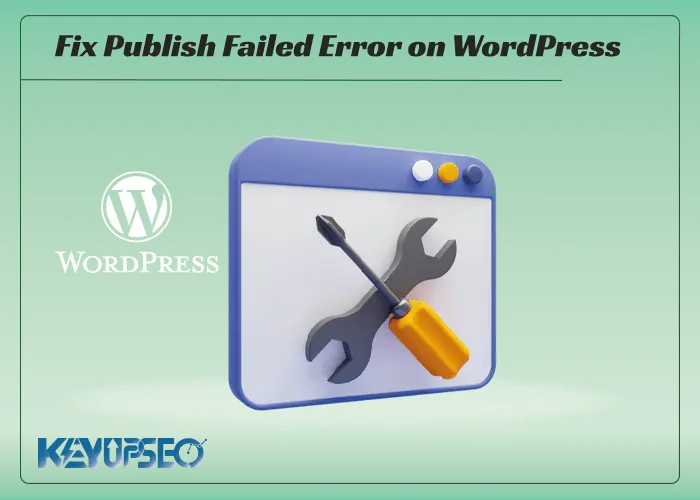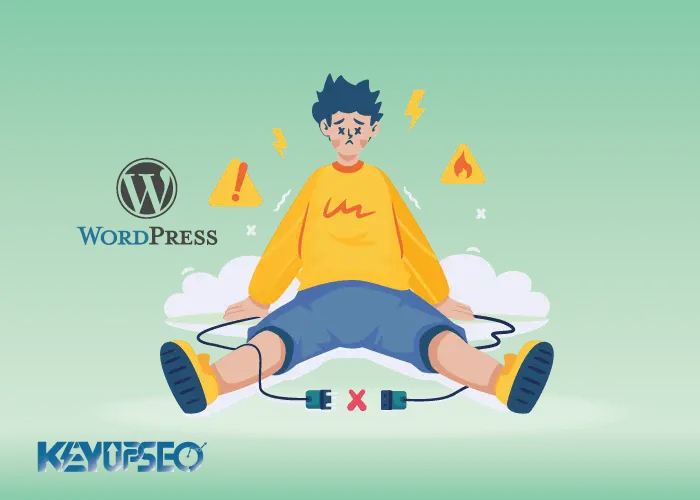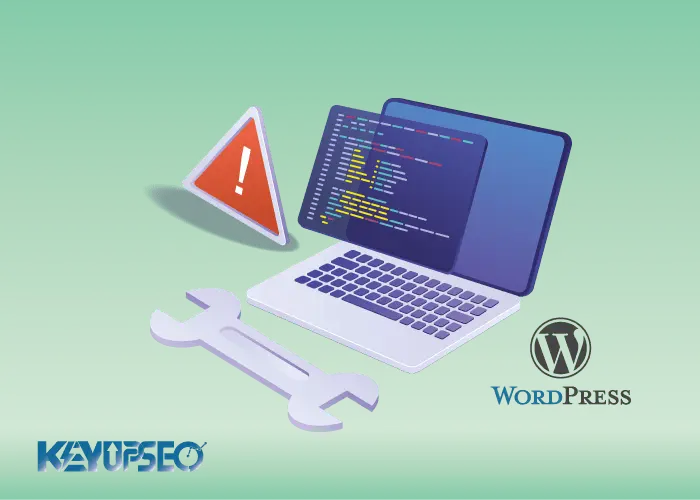
How to fix the failed publishing error on WordPress?
When editing a post or page, you may see an update failed error, and we will teach you how to fix the publishing failed error on WordPress.
This error gives no clues and makes the problem especially difficult for beginners.
As a WordPress site administrator, you should be able to fix all kinds of errors in it, and one of the most common is the page publishing error.
Be careful that after fixing the problem, for better ranking in Google results, Buy SEO traffic helps to improve SEO.
In this content from the KeyUpSeo blog, you will learn how to fix the failed publication error for WordPress pages with 7 simple methods.
Publish failed error on WordPress
First, we must look for the reason. What happened that we received such an error?
Failure to communicate with the WordPress REST API will result in an "update failed" or "failed to publish to WordPress" error.
Basically, WordPress sometimes uses a set of APIs (programming methods) called REST APIs to send and receive requests to the WordPress database.
If it can't send and receive those requests, some parts of your WordPress website may not work. This includes the WordPress block editor, which uses an API to send update and publish requests to WordPress.
Why can't WordPress use REST API?
Now you might be wondering if I didn't make any changes to my website, then why isn't the REST API working on its own?
There are several scenarios that may prevent WordPress from using the REST API. For example, you may not be connected to the Internet or you may have lost your connection.
Other reasons may be a little more complicated. For example, you may have accidentally changed the site's URL, a WordPress plugin may be causing the problem, or another service may be blocking API calls.
Now that we've looked at the reasons, let's take a look at how to troubleshoot and fix the publishing failed error on WordPress.
-
Check your internet connection and website URL
The most common reason for WordPress update failed error is loss of Wi-Fi connection. If your computer disconnects from the internet while writing a post, WordPress will not save your changes. Make sure you are connected to the Internet by visiting other websites in a new browser tab.
If your internet is working fine, the next thing to check is your WordPress site's URL settings. To do this, simply go to the General Settings page and make sure that the Site URL and WordPress URL options are correct. For most websites, you should have the same URLs in both parts.
If your site's URL settings are the same and correct, and you are connected to the Internet, go to the next steps.

-
Check REST API status using WordPress health
WordPress has a built-in site health tool that shows important information about your site's security and performance. To view the report, just go to Tools > Site Health page. If the REST API isn't working, you'll see it under Recommended Improvements because the REST API encountered an unexpected result.
It may also show you some debugging information that may explain what happened when WordPress made the REST API call. Reading this thread may give you a clue as to which add-on or secondary service is causing the problem. However, if it doesn't give you any clues, you can move on to the next step.
-
Disable all WordPress plugins
If a WordPress plugin is causing the REST API to misbehave, the easiest way to find out is to disable all WordPress plugins. You can go to Plugins > Installed Plugins page and tick all to select all plugins. After that, use the Bulk Actions dropdown to disable all plugins.
After that, you can go to the post-edit page and try to update. If the WordPress update failed error disappears, it means that one of your plugins is causing the problem.
Now you can activate your WordPress plugins one by one and try to repeat the update.
Once you find the plugin, you can get support from the plugin author or find an alternative plugin.
Alternatively, if disabling all WordPress plugins does not resolve the error, proceed to the next step.
-
Check the site's firewall service
If you use a website firewall service like Sucuri or Cloudflare.
These services may block REST API requests. This can happen if their firewall filters find your IP address suspicious.
If your website is subjected to a DDoS attack, REST API requests may be blocked.
If you're using Cloudflare, you can temporarily disable Cloudflare to see if that fixes your problem. Typically, you'll find Cloudflare's settings in the Domains section of your hosting dashboard.
-
Activate WordPress debug mode
WordPress has a built-in feature to log all WordPress errors. It doesn't log REST API errors, but it helps you see if other issues might be causing this error. For this purpose, add the following lines to your wp-config.php file:
// Change WP_DEBUG to true
define('WP_DEBUG', true );
// Keep a log of WordPress errors
define('WP_DEBUG_LOG', true );
Don't forget to save your changes and re-upload the file to your server. You can now try to publish or update a post on WordPress to check for a WordPress publishing failed error.
After that, you can connect to your WordPress hosting account using an FTP client and navigate to the /wp-content/ folder. You can download the debug.log file from here.
Now you can open the debug file in a simple text editor like Notepad. It may contain some errors, warnings, or warnings that are recorded by WordPress when working on your site or when the user visits it. If you see something that points you to a plugin or theme file, that can be a helpful clue to fix the problem or get help from an expert.

-
Temporarily migrate to the classic WordPress editor
A temporary workaround to resolve this error is to enable the classic editor. This is an older WordPress editor that does not rely on the REST API to update and publish content.
You can activate it by installing and activating the Classic Editor plugin. Once activated, you can easily edit the post you were working on. Also, save and publish it without seeing the publishing failed error on WordPress.
-
Get help from a specialist
If all steps fail, you may need to request support. You can start by contacting your hosting provider directly. They have access to server logs and additional tools.
It may also be due to misconfiguration of the server or a bug in their work. After that, if the problem is not solved, we suggest that you contact professional WordPress developers and raise the problem.
WordPress update failed error
WordPress, like many other systems, sometimes suffers from errors.
Fortunately, by now, there are solutions for every common WordPress error. Today, we also checked another common error called the failed publishing error on WordPress and provided you with 7 basic solutions that you will get results with.
By reading the contents of the WordPress KeyUpSeo section, increase your knowledge in the field of WordPress sites, management, and troubleshooting.
In the following, we will answer some of the most common questions of people about page update errors or publication errors, and we have briefly provided the methods to fix this problem.
What is a Publish Failed Error on WordPress?
Failure to communicate with the WordPress REST API will result in an "update failed" or "failed to publish to WordPress" error.
Why can't WordPress use REST API?
Several reasons might prevent WordPress from using the REST API. For example, you may not be connected to the Internet or you may have lost your connection. Other reasons may be a little more complicated. For example, you may have accidentally changed the site's URL, a WordPress plugin may be causing the problem, or another service may be blocking API calls.
How to Fix Publish Failed Error on WordPress?
1- Check the internet connection and URL of your site 2- Check the status of the REST API using WordPress health 3- Disable all WordPress plugins 4- Check the site firewall service 5- Activate the WordPress debug mode 6 - Temporarily migrate to the classic WordPress editor 7- Get help from an expert.
Release date : 22 May, 2024













